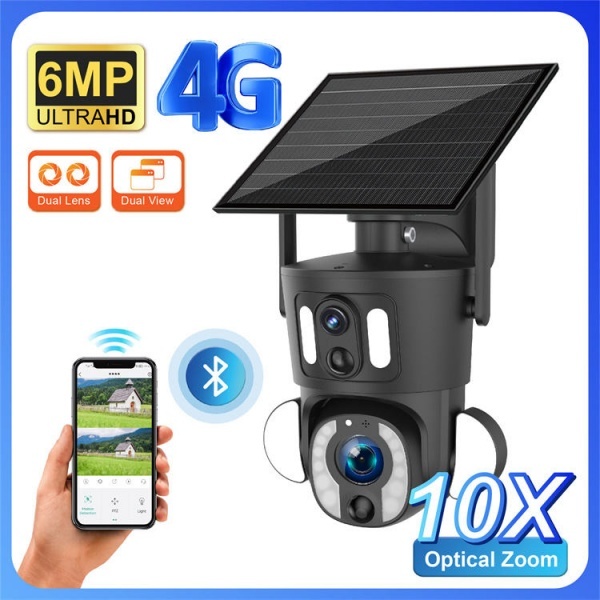Enhancing Campsite and Outdoor Recreation Security: A B2B Guide to Solar-Powered Surveillance
For operators of campsites, RV parks, and outdoor recreational facilities, providing a secure environment is paramount. However, traditional security solutions often fail in remote locations due to two critical missing components: reliable power and stable internet connectivity. This gap leaves valuable assets and guests vulnerable, creating significant liability and operational challenges. As an engineer with over a decade of experience in this specific field, I’ve seen firsthand how these challenges directly impact business profitability and reputation.
The core problem lies in the prohibitive cost and logistical nightmare of trenching power lines and data cables across rugged, expansive terrain. This leaves many sites with security blind spots, making them easy targets for theft of guest property, vandalism of facilities, and unauthorized access. For B2B clients—from 4G operators looking to expand their IoT offerings to security equipment distributors—this represents a massive, underserved market. The solution is not to adapt old technology, but to embrace a solution designed from the ground up for off-grid environments: the 4G solar security camera.
Why Traditional Surveillance Fails in the Wild
Conventional CCTV systems are fundamentally designed for urban and suburban settings. Their reliance on a constant power supply and wired internet connections (or short-range Wi-Fi) makes them completely impractical for most outdoor recreational areas. Attempting to deploy them involves overcoming significant hurdles.
The process often requires expensive civil engineering work, permits, and extensive cabling, driving up initial investment costs to an unsustainable level. Furthermore, these systems lack the flexibility needed for seasonal operations or temporary event monitoring. For a business owner, this means high capital expenditure for a rigid system that cannot adapt to changing security needs. This is where purpose-built, off-grid technology provides a decisive advantage.
The Power of Solar and 4G: A Technical Breakdown
A solar-powered 4G security camera is an entirely self-sufficient surveillance unit. It integrates a photovoltaic (PV) solar panel, a high-capacity rechargeable battery with a sophisticated Battery Management System (BMS), and a 4G LTE cellular modem into a single, ruggedized device. This design directly solves the core challenges of remote monitoring.
- Continuous Power: The solar panel charges the internal battery during daylight hours. A high-quality BMS is crucial here; it prevents overcharging, manages discharge rates, and optimizes battery health for longevity, ensuring the camera operates through multiple cloudy days and nights. You can learn more about the importance of BMS technology in our detailed guide.
- Reliable Connectivity: By using a 4G LTE data connection, the camera bypasses the need for Wi-Fi or physical cables. It transmits video footage over cellular networks, allowing for real-time monitoring and alert notifications from anywhere in the world via a mobile app or central management software. This is a game-changer for managing remote properties.
- Rapid Deployment: Installation is simple. Since there is no wiring required, a camera can be mounted on a pole or tree and become operational in under an hour. This “security-on-demand” capability is invaluable for temporary events, seasonal campsites, or responding to emerging security threats.
Comparative Analysis: Off-Grid Security Solutions
To provide clear value for your customers, it’s essential to understand how different technologies stack up in a campsite environment. Here’s a direct comparison for wholesalers, installers, and brand owners to consider when building their product portfolio.
| Feature | Traditional Wired CCTV | Solar-Powered Wi-Fi Camera | Solar-Powered 4G Camera (Recommended) |
|---|---|---|---|
| Power Source | Requires mains power grid | Solar panel & battery | Solar panel & battery |
| Connectivity | Wired Ethernet/Coaxial | Requires nearby Wi-Fi router (within ~100-300ft) | 4G LTE Cellular Network (Independent) |
| Installation Cost | Very High (trenching, cabling, labor) | Low | Low to Moderate (device cost + data plan) |
| Flexibility & Scalability | Poor (fixed infrastructure) | Moderate (limited by Wi-Fi range) | Excellent (deploy anywhere with cell service) |
| Ideal Use Case | Buildings with existing infrastructure | Backyards, driveways, areas near a main building | Campsites, farms, construction sites, remote assets |
Case Study: Securing a Remote National Park Trailhead
Problem: A national park authority was dealing with consistent vandalism at a remote trailhead parking lot. Vehicles were being broken into, and illegal dumping was a persistent issue. With no power or internet, traditional surveillance was not an option, and the cost of staffing the location 24/7 was prohibitive.
Solution: We worked with a local security installer to deploy three of our UBOXCAM 4G solar-powered PTZ cameras. Two were positioned to overlook the main parking area, while a third monitored the access road. The cameras were configured with motion-activated recording and push alerts sent directly to the park rangers’ smartphones. The entire installation took less than a day.
Result: Within the first three months, the presence of the visible cameras acted as a powerful deterrent, reducing reported vehicle break-ins by 90%. On two occasions, the high-definition footage was used to identify individuals involved in illegal dumping, leading to successful prosecutions and fines. The park authority estimated saving over $20,000 annually in cleanup and repair costs, delivering a clear return on investment in under six months.
A Practical Selection Guide for Your Business
For distributors, installers, and entrepreneurs entering this market, helping your clients choose the right camera is key to building trust and ensuring customer satisfaction. Use this checklist as a guide for consultation and product selection:
- Assess Cellular Coverage: Before anything else, verify the 4G signal strength from major carriers (e.g., Verizon, AT&T, T-Mobile in the US; Vodafone, EE in the UK) at the exact installation points. A weak signal may require a model with an external high-gain antenna.
- Evaluate Power Requirements: Consider the location’s average daily sunlight. In areas with long winters or frequent overcast days, such as the UK or Pacific Northwest, opt for a system with a larger solar panel and higher-capacity battery to ensure uptime.
- Determine Field of View: Does the application require monitoring a wide area like a field, or a specific entry point? A fixed-lens camera is suitable for gates and doorways, while a Pan-Tilt-Zoom (PTZ) camera offers the flexibility to survey large open areas like common grounds or parking lots.
- Night Vision Needs: Standard infrared (IR) night vision provides clear black-and-white images in total darkness. For applications where color detail is critical at night, such as identifying the color of a vehicle or clothing, a camera with “Starlight” or “Full-Color” night vision technology, often assisted by a white light LED, is superior. Explore the differences in our night vision technology comparison.
- Durability and IP Rating: Ensure the camera has at least an IP66 rating, certifying it is dust-tight and can withstand powerful jets of water. This is non-negotiable for any device intended for permanent outdoor installation in regions like Germany or Canada, which experience harsh weather.
Troubleshooting Common Field Issues
As an engineer, I believe that demonstrating expertise includes solving problems. Here are common issues and their solutions—valuable knowledge for your technical support teams and installer partners.
Issue 1: The camera disconnects or has an unstable 4G connection.
Solution: This is almost always a signal strength problem. First, check the carrier’s coverage map. Second, try moving the camera to a slightly higher or different position, even a few feet can make a difference. If the problem persists, use a model that supports an external 4G antenna for a significant signal boost.
Issue 2: The battery drains too quickly, especially in winter.
Solution: This is a power budget issue. Ensure the solar panel is clean and positioned to receive maximum direct sunlight, facing south in the northern hemisphere. Reduce the frequency of live viewing and motion-triggered recordings if possible. Most importantly, use a camera with an efficient, low-power standby mode and a robust BMS to protect the battery in cold temperatures.
Issue 3: Too many false motion detection alerts (e.g., from trees, animals).
Solution: Modern cameras often feature PIR (Passive Infrared) sensors combined with AI-powered human and vehicle detection. This dual-tech approach significantly reduces false alarms. Advise clients to adjust motion sensitivity settings in the app and define specific activity zones to ignore irrelevant movement.
Partner with an Expert in Off-Grid Security
The demand for reliable, off-grid security solutions for campsites, recreational areas, and other remote locations is growing rapidly. This is no longer a niche market; it is a fundamental need for a wide range of businesses. By offering high-quality, durable, and easy-to-deploy solar 4G security cameras, you can provide immense value to your customers and capture a significant market share.
As a specialized design and production factory, UBOXCAM offers robust customization (OEM/ODM) services and competitive pricing to help you build your brand. We understand the technical nuances and supply chain intricacies required to deliver a product that performs in the wild. Contact our engineering team to discuss your specific needs and discover how our solar surveillance solutions can drive your business forward.

